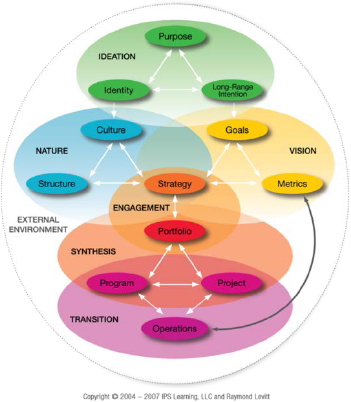Change Management in Accessibility: Strategic Execution Framework
Note: This blog post is part five, our final post in a series on change management for accessibility. Read part 1, part 2, part 3, or part 4 to get caught up before reading the post below!
The next change model differs from the others we have discussed so far because this model is not about the how, this model is about where. This approach is crucial to discuss because I have tried a change in an organization only to realize it was not working because I was focusing on the wrong area of the organization for the change. I started wondering, did I consider all the distinct parts that I needed to support the change that I am making?
Strategic Execution Framework (SEF)
Defining and managing the changes is a challenge for many organizations. The Strategic Execution Framework (SEF) of the Stanford Advanced Project Management (SAPM) supplies an approach for targeting change and moving businesses through effective transformational change.
The acronym INVEST stands for ideation, nature, vision, engagement, synthesis, and transformation, and it encompasses six areas. This model helps businesses in retooling their strategies and it also aids in the choice and execution of strategic projects.
Below is a venn diagram outlining the various components of each letter in the acronym and how they overlap and work together:

I – Ideation
Passion and drive are born in the realm of ideation. Ideation is the process by which your firm decides what the change is and how it will manifest in the real world.
The company’s concept is expressed through its mission, identity, and long-term vision. The company’s personality image, brand, and ideals are all part of its identity. It shows the company’s identity and decides its competitiveness. The company’s existence is founded on its mission. It motivates people to come to work every day and keeps them focused on their work. Finally, long-term vision is success through time and defines their commitments.
If I decide that accessibility was crucial to my company, am I successfully answering “yes” to the following questions:
• Is it supported by the mission statement?
• What part of my brand shows that accessibility is a priority for me?
• How can I convince the rest of the organization that this is not a fad and that accessibility is part of my long-term strategy?
The idea is important, but action items from the organization let others know it is important to us long term.
N – Nature
Nature sets the stage for the strategy’s implementation. The culture, the structure, the environment, and the context in which it works are all part of strategy.
The outcomes, basic values, activities, and how the company gets things done are all part of the culture. Structures are a mechanism for an organization to set up connections between departments. Finally, strategy is the road map for a company. Again, accessibility is a part of a company’s culture, which supports this path.
Important questions to consider:
• Is it possible to connect the value of accessibility to a company value or a personal value?
• Is there anything in the framework that could make it difficult?
• Did the structure of the accessibility adoption make it appear that accessibility is merely something that the team needs to do, or that we wove it into the fabric of the team?
V – Vision
Goals, measurements, and business strategies are all part of the vision. Goals define clear and desirable outcomes. Metrics show how far you have come toward your goals. A company’s strategy is its road plan for conducting its goals and objectives.
Important questions to consider:
- What are my accessibility goals?
- Is accessibility a part of the company’s overall goals?
- What am I looking for with accessibility?
People work hard on what we measure them on, as I have discovered in my personal experience. It is important to ask the question: is it the positive outcomes that I am assessing, or is it the negative outcomes I am measuring? Because when people perceive positive results, they are more likely to repeat the behavior.
E – Engagement
It is critical to connect our strategy to the company’s portfolio investments, corporate funding, and the projects to implement it. A company’s strategy is its road plan for achieving its educational goals and aims. Our company and organization’s best path are how we get the job done.
We refer to the combination of programs and efforts that put this in place as a portfolio. What we intend to achieve is reflected in the strategy and portfolio. What we intend to achieve is reflected in the strategy and portfolio.
Important questions to consider:
- How am I going to pay for my accessibility initiatives?
- Do several parties have a personal stake in the success of accessibility?
If the answer is yes to the questions above, the likelihood of accessibility succeeding significantly increases.
S – Synthesis
Portfolios, programs, and projects are all part of the synthesis process. Portfolios are the projects and activities that have been implemented. A program is a collection of related projects. A project is a one-of-a-kind, focused endeavor. This is usually where we concentrate our modifications, and the changes must be tactical.
But, as you can see from the top of the model, this also emphasizes that we have gone beyond to ensure success.
Important questions to consider:
- What will ensure that this is the new status quo rather than a return to the status quo?
Synthesis is where planning meets execution. It drives innovation by enabling the organization to invest in and act on innovation projects and overcome obstacles that may get in the way, optimizing performance by defining and managing the scope, deliverables, schedules, and resources of individual projects.
T – Transition
You will transform the output into operations during the transition phase. Transition is a metric of success since it allows us to apply project-based work results and is at the heart of our company’s operations.
A project is a one-of-a-kind concentrated endeavor, while a program is a collection of interconnected initiatives. The business is the company’s continual process of delivering those values to customers.
Important questions to consider:
- How can I make accessibility a natural part of our day-to-day operations, rather than an afterthought?
Imagine you were trying to implement accessibility in your organization. Someone might ask you, “Do you want me to do accessibility with everything else I do? How am I supposed to fit this in with the rest of my work?”
I look at accessibility remarkably similar to how I also look at security. It is a non-functional requirement of the product itself. A non-functional requirement is one that defines criteria that can evaluate a system’s performance rather than specific actions. Functional requirements define precise behavior or functions. The system design includes a plan for implementing functional requirements. Because non-functional requirements are often architecturally significant, we outline the plan for implementing them in the system architecture. Non-functional requirements are criteria for evaluating how a software system should work, and to meet non-functional requirements, a software system must have specific quality attributes.
Given that accessibility is a non-functional criterion, what if I rephrased the question to include another non-functional demand: security? What if someone asks, “Do you want me to do security besides everything else I have to do?”
“Yes, I would expect you to do security,” the response would be. “Security is the basis of doing business in the internet age.”
The purpose, identity, long-term goals, culture, structure, goals, measurement, strategy, portfolio, program, projects, and operations of organizations have all been aligned with security. Because of that alignment, we give security priority in organizations.
We remember that this security mindset did not appear overnight; it developed because of the brand’s risk and as a customer expectation. The corporation wanted to show how well they secured my personal information to gain a competitive advantage.
It is important to note a lot of these same arguments that are made for security can also be made with accessibility.
Summary
We have discussed the importance of change management and the many change management strategies you can employ to advance accessibility in your organization. We have gone over four different change management strategies, but there are plenty more to discover. Each company and environment require a different approach. It is possible that a combination of strategies will be the most beneficial.
When deciding on a change strategy, think about what is most important to the change participants and the organization. Is it a focus on precision, consistency, and uniformity? Is a major emphasis on lifetime learning, agility, and speed placed on the students? It is important to remember that managing change is never too early. Without it, transitions can be tough.
